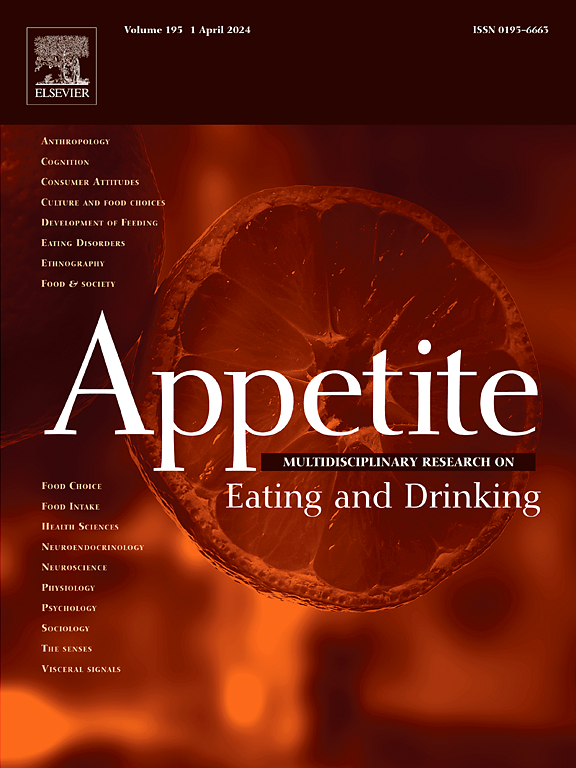Applying machine learning to ecological momentary assessment data to identify predictors of loss-of-control eating and overeating severity in adolescents: A preliminary investigation
IF 3.8
2区 医学
Q1 BEHAVIORAL SCIENCES
引用次数: 0
Abstract
Objective
Several factors (e.g., interpersonal stress, affect) predict loss-of-control (LOC) eating and overeating in adolescents, but most past research has tested predictors separately. We applied machine learning to simultaneously evaluate multiple possible predictors of LOC-eating and overeating severity in pooled and person-specific models.
Method
Twenty-eight adolescents (78.57% female, age = 15.87 ± 1.59 years, BMI %ile = 92.71 ± 8.86) who endorsed ≥ two past-month LOC-eating episodes completed a week-long ecological momentary assessment protocol. Pooled models were fit to the aggregated data with elastic-net regularized regression and evaluated using nested cross-validation. Person-specific models were fit and evaluated as proof-of-concept.
Results
Across adolescents, the median out-of-sample R2 of the pooled LOC-eating severity model was .33. The top predictors were between-subjects food craving, sadness, interpersonal conflict, shame, distress, stress (inverse association), and anger (inverse association), and within- and between-subjects wishing relationships were better. The median out-of-sample R2 for pooled overeating severity model was .20. The top predictors were between-person food craving, loneliness, mixed race, and feeling rejected (inverse association), and within-subjects guilt, nervousness, wishing for more friends (inverse association), and feeling scared, annoyed, and rejected (all inverse associations). Person-specific models demonstrated poor fit (median LOC-eating severity R2 = .003, median overeating R2 = −.009); 61% and 36% of adolescents’ models performed better than chance for LOC-eating and overeating severity, respectively.
Discussion
Altogether, group-level models may hold utility in predicting LOC-eating and overeating severity, but model performance for person-specific models is variable, and additional research with larger samples over an extended assessment period is needed. Ultimately, a mix of these approaches may improve the identification of momentary predictors of LOC eating and overeating, providing novel and personalized opportunities for intervention.
将机器学习应用于生态瞬时评估数据,以识别青少年饮食失控和暴饮暴食严重程度的预测因素:初步调查
几个因素(例如,人际压力,情感)预测青少年饮食失控(LOC)和暴饮暴食,但大多数过去的研究都单独测试了预测因素。我们应用机器学习同时评估了混合模型和个人特定模型中loc进食和暴饮暴食严重程度的多种可能预测因素。方法28名青少年(78.57%,女性,年龄= 15.87±1.59岁,BMI % = 92.71±8.86)在过去一个月中有≥两次loc进食事件,完成为期一周的生态瞬时评估方案。混合模型采用弹性网正则化回归拟合聚合数据,并采用嵌套交叉验证进行评估。个体模型被拟合并评估为概念验证。结果在青少年中,loc进食严重程度模型的样本外R2中位数为0.33。最主要的预测因素是受试者之间对食物的渴望、悲伤、人际冲突、羞耻、痛苦、压力(负相关)和愤怒(负相关),以及受试者内部和受试者之间希望关系更好。混合暴饮暴食严重程度模型的样本外R2中位数为0.20。最主要的预测因素是人与人之间的食物渴望、孤独、混血儿和被拒绝的感觉(反向关联),以及在受试者内部的内疚、紧张、希望有更多的朋友(反向关联)、感到害怕、烦恼和被拒绝(所有的反向关联)。个体模型的拟合度较差(进食严重程度中位数R2 = 0.003,暴饮暴食中位数R2 = - 0.009);61%和36%的青少年模型在低摄入量饮食和暴饮暴食严重程度上的表现分别好于机会。总之,群体水平的模型在预测低摄取量和暴饮暴食的严重程度方面可能具有实用性,但模型对个人特定模型的性能是可变的,需要在更长的评估期内进行更大样本的额外研究。最终,这些方法的混合可能会提高对LOC饮食和暴饮暴食的瞬时预测因素的识别,为干预提供新颖和个性化的机会。
本文章由计算机程序翻译,如有差异,请以英文原文为准。
求助全文
约1分钟内获得全文
求助全文
来源期刊

Appetite
医学-行为科学
CiteScore
9.10
自引率
11.10%
发文量
566
审稿时长
13.4 weeks
期刊介绍:
Appetite is an international research journal specializing in cultural, social, psychological, sensory and physiological influences on the selection and intake of foods and drinks. It covers normal and disordered eating and drinking and welcomes studies of both human and non-human animal behaviour toward food. Appetite publishes research reports, reviews and commentaries. Thematic special issues appear regularly. From time to time the journal carries abstracts from professional meetings. Submissions to Appetite are expected to be based primarily on observations directly related to the selection and intake of foods and drinks; papers that are primarily focused on topics such as nutrition or obesity will not be considered unless they specifically make a novel scientific contribution to the understanding of appetite in line with the journal's aims and scope.
 求助内容:
求助内容: 应助结果提醒方式:
应助结果提醒方式:


